Welcome back friends, I hope you are enjoying this series so far. Today I'll be talking about another of the hot rod art pioneers and one of my personal heroes "Big Daddy" Ed Roth. Big Daddy was one of the reasons I was inspired to write the entire series. Roth passed away a few years ago, and Von Dutch passed on a decade earlier. If you remember I mentioned that artist Dave Deal has passed away last year. A good number of artists in the automotive world were leaving us too soon. While their legacy was celebrated in the car circles it seemed that very few outside even knew or cared. I felt that their passing should be honored and remembered, especially on 1UP where sometimes the community isn't focused on this culture.
Ed Roth was a character and a half. Like Von Dutch he had his hands in everything within rod culture. Always the showman you could expect to see Roth show up at car shows sporting a suit with tails, a top hat and monocle. His custom rods were some of the first built specifically with the show circuit in mind. Not content with chopping and painting an older-model coupe, Roth and his friends created rolling works of hot rod art. The frames and engines sometimes chromed and polished themselves with a body sculpted by hand. Roth rarely bothered with a measuring tape while applying plaster of paris over a mock-up frame made of plywood in order to create his outlandish fiberglass bodies. Each of these rods were more innovative and mind bending than the last.
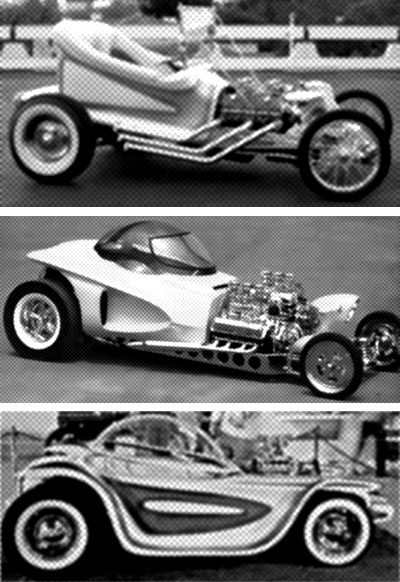
The "show rods" that Roth helped pioneer were part of a new rodding movement. Most of Roth's work were functional cars, no matter how outlandish they were they could at least move under their own power. Some show rods by other artists were non-functional and had to be pushed out. They were artistic statements extending beyond the traditional hot rod culture of converting old cars into racers. These artistic rods were made out of everything from a telephone booth to a tank, ultimately turning up everywhere in pop culture, from films and television shows to comics and cartoons. The hand-built cars from Roth, although not always the most popular in car circles during the 60's eventually became highly-sought collectors items. In recent years an original, restored Roth car, has earned over a million dollars at auction. One of the most interesting Roth stories of recent years was the discovery and restoration of his Orbitron. However show rods were not the only major influence Roth held over the culture. His biggest legacy was arguably from his airbrushed monster shirts.
In the early 60's Roth and his contemporaries would airbrush shirts for car clubs and fans at conventions. Roth worked alongside legendary art and car visionaries such as Dean Jeffries, Richard Ash, Stanley "Mouse" Miller, Ed "Newt" Newton and Gary Olsen. After drawing countless shirts the men started changing up their renderings to stave off boredom. What came from the experimentation were the caricatured cars and the cartoon-style hot rods that we've all seen associated with the genre. These would be the seemingly flexible cars with gigantic motors in the front and balloonish tires in the back, doing a "wheelie." Often-times a bug-eyed monstrous character would be driving these rods. In some cases the shirts featured only the monsters themselves. The majority of Roth's famous characters and rod designs were actually created by Ed "Newt" Newton. The monsters proved wildly popular with teens and created a phenomenon.
Youngsters, especially young boys and teenagers in So. Cal., were drawn to the gross-looking characters and their monster rods. They were looking for a symbol that skirted the sterilization that the Comics Code Authority placed on comic books. While the monsters were covered in warts or had razor sharp teeth and bug-eyes, at no point were they committing acts of sex or violence, hence they weren't in violation of the decency laws. Many say that the inspiration for the monsters was based on Basil Wolverton's Lena Hyena in the pages of the Li'l Abner comic. Lena Hyena worked so well for shock value that Newt and his boss would refine the style and make it their own. Eventually they produced trading cards and stickers with their monstrous creations.
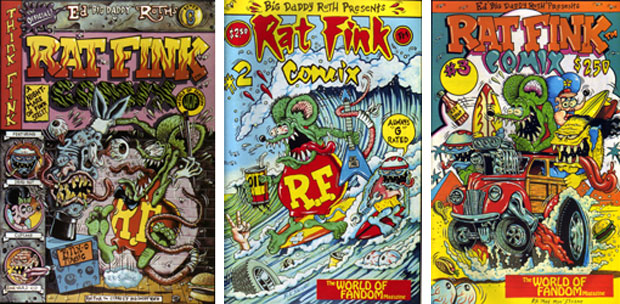
The covers of the Rat Fink comic books, published in the 90's, were not misleading, the adventures of Rat Fink, Cupcake, Drag Nut and the Junkyard Kid really were all G-rated. The adventures were nonsensical, stream-of-consciousness storytelling with some of the craziest black and white panels ever committed to print. As manic as they were the stories and situations were also filled with plenty of comedy and earnest good fun, they were never violent nor gory so could be picked up by anybody. The shocking characters were abhorred by parents which made the youngest members of the counter-culture identify with the monsters even more.
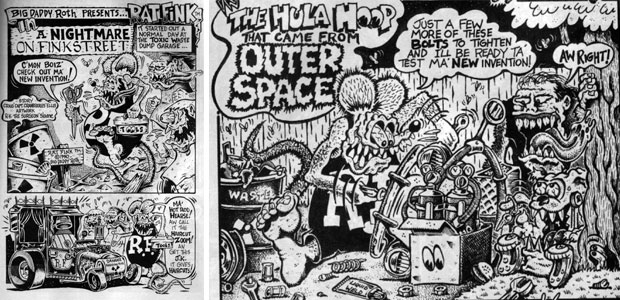
While many people think that Rat Fink was the antithesis of Mickey Mouse his origins are actually a sort of homage to Mickey. In an interview Roth was asked where the inspiration for the grotesque monsters came from. He explained that they were simply de-evolved cartoon characters. Roth produced an illustration of Mickey Mouse circa his Fantasia years. He mentioned that while we knew this was how Mickey looked, the character didn't always look like that. He then drew a version of the mouse from the earliest black and white films. Very rough but still recognizable. He then drew a rat monster and said if you go back far enough maybe Mickey's dad looked like that. He put the drawing away for the rest of the interview but returned to it soon after. He thought that this monster rat had something unique going for it and reproduced it on a shirt. Rat Fink was born from Roth's love of the Disney character, not as many believe an anti-commercialism rant against the mouse. It would be hypocritical to say that Roth was against the business since he sold tons of products with his characters and gladly signed deals with Revell to produce models based on his cars.
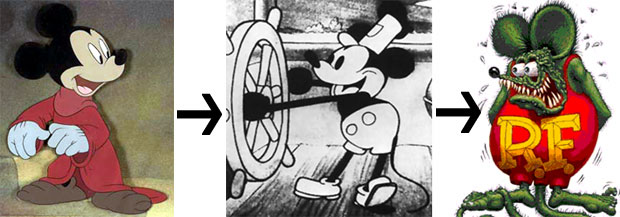
It is safe to say that a major influence on the underground comix scene from the late 60's was through Roth and Newt. The iconic "lowbrow" painter Robert Williams even spent time as an art director at the Roth studios. Williams was heralded as a pioneer of a new artistic movement alongside people like Robert Crumb and Bill Wray. Their odd comics and figures were definitely unlike anything produced by the mainstream comic book companies. This counter-culture art movement was more than a fad, like the rod culture itself, it would continue to grow and evolve until it found acceptance in the mainstream.
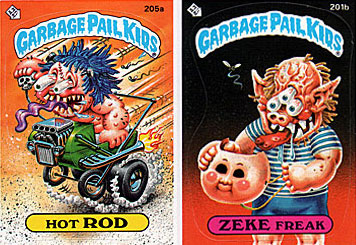
Decades later the gross art style that Roth made popular returned with the phenomenally successful Garbage Pail Kids trading cards. It seemed that no matter how far hot rod art was from popular consciousness it could not completely escape its pull. The monster characters and monster hot rods have now been part of American culture for at least 40 years. There is no sign of the culture slowing as it spreads across the globe and has strong following from places like Finland, South Africa and Japan. As for the man himself there are plenty of books about Roth and his influence plus a documentary film. If you are an artist and looking to learn the monster art style then look no further than this How to Draw book by Thom Taylor and the master Newt himself. But I'm not done talking about the art of rodding, tomorrow I'll talk about an artist that forever changed the world of hot rodding.
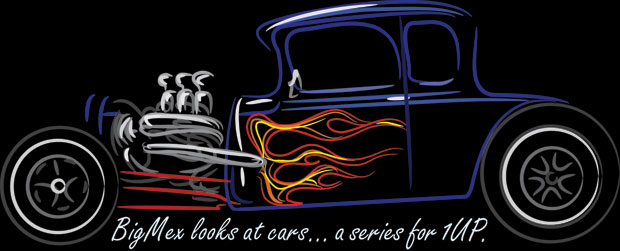

No comments:
Post a Comment